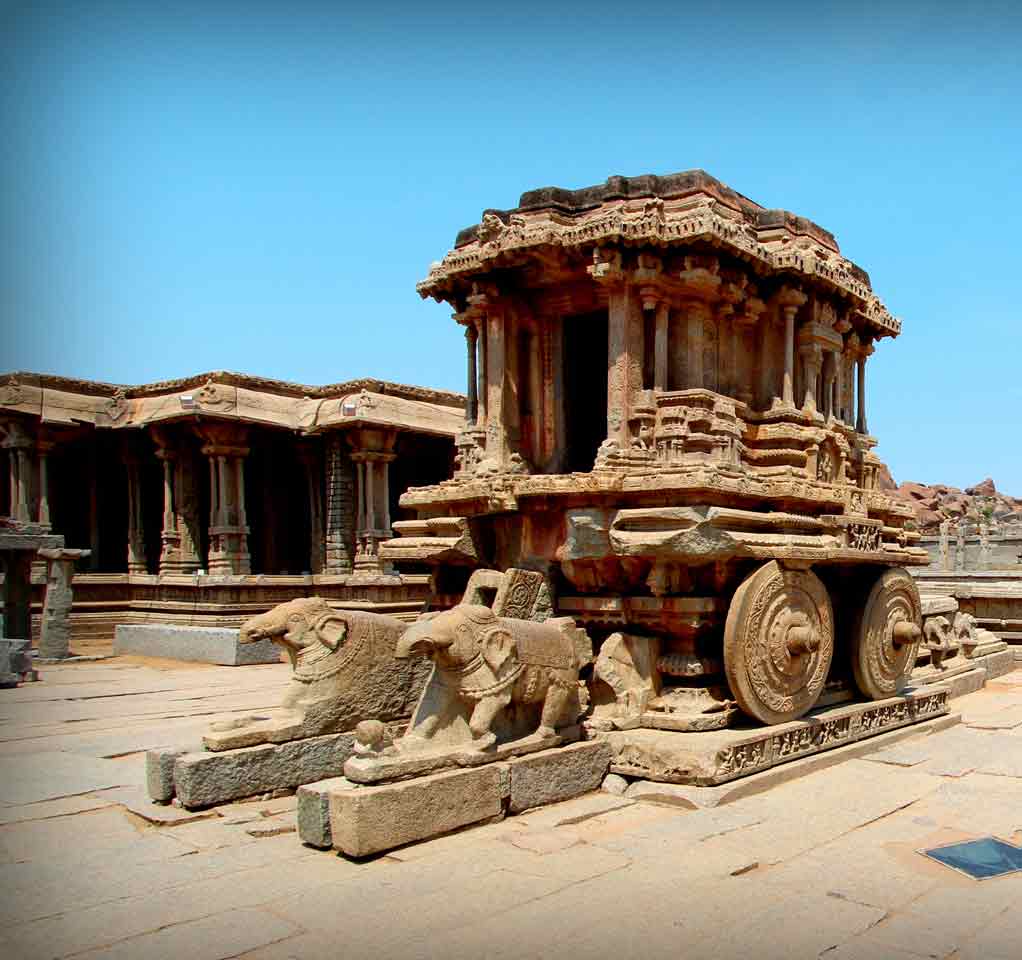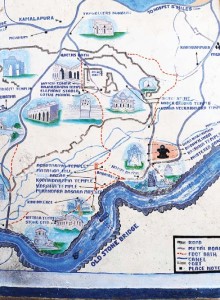
Hampi is a small village on the southern bank of the Tungabhadra River in Bellary district of Karnataka. Traditionally known by many names such as Pampa Kshetra, Kishkinda Kshetra, Bhaskara Kshetra, Vidyanagara, Virupakshapura, Hosapattana, Hosa Hampapattana, Hastinavathi, Hampe Hastinavathi and Kunjarakona, the village has been an important pilgrimage centre since ancient times. Pampa is the ancient name of the Tungabhadra River. The word Hampe or Hampi is generally held to be a later Kannada form of Pampa.
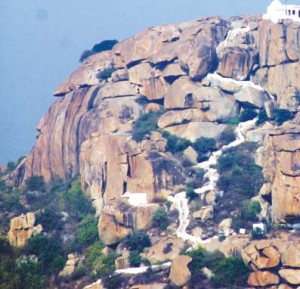
Hampi was the capital of the powerful Vijayanagara kingdom from AD 1343 to 1565.
Mythological links with Ramayana
Hampi and its environs are considered to be holy ground as many of its sites and names are associated with episodes of the Ramayana. Kishkindha Kshetra of the Ramayana is believed to have been situated close to Hampi. According to the epic, the kingdom of Kishkindha was ruled by the monkey chiefs Vali and Sugriva. A quarrel broke out between them and Sugriva, who had been driven out, took refuge on the Matanga Parvata (a steep hill to the east of Hampi), along with his deputy Hanuman.
When the demon king Ravana abducted Sita (wife of Lord Rama) and carried her away to Lanka, Rama and his brother, Lakshmana, came in search of her and met Sugriva and Hanuman. Rama killed Vali and restored Sugriva his kingdom and stayed on the Malyavanta Hill (a hill on the road to Kampili) nearby awaiting Hanuman, who had gone in search of Sita to Lanka.
A huge mound of ash in the adjacent village of Nimbapuram is believed to be the cremated remains of Vali. A cavern on the southern bank of the Tungabhadra is said to be the cave where Sugriva hid Sita’s jewels for safety, while certain marks and streaks on the sheet rock near it are pointed out as marks made by Sita’s discarded garments. Two other hills, the Anjanagiri and Rishimukha, and the sacred tanks of Pampasaras on the northern bank of the Tungabhadra are also believed to be associated with the Ramayana.
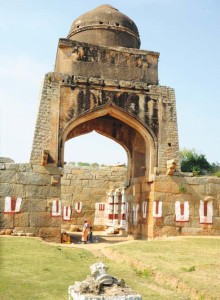
Dynasties who ruled Hampi
Kings of four different dynasties ruled over the Vijayanagara kingdom. Harihara and Bukka of the Sangam dynasty founded the splendid city of Vidyanagara the capital of their newly established empire in 1336 AD. Sage Vidyaranya of Sringeri Matha played a significant role in the empire building. The new city lay on the southern bank of the Tungabhadra, opposite the older fortress of Anegundi and was completed by 1343. The Vijayanagara kings chose a boar (representing the third incarnation of Vishnu) as their heraldic crest and used the title Virupaksha to signify that they were the deputies of the patron deity Virupaksha.

The empire established on a firm footing during the reign of the Sangama dynasty (1336-1486) but declined in stature during a short period of weak rule of Saluva dynasty 1485-1491 AD. Sri Krishnadeva Raya, whose name is synonymous with the third dynasty (Taluva dynasty, 1491-1570 AD) was crowned the king on 8 August 1509. He proved to be one of the greatest and most brilliant rulers of the Vijayanagara kingdom, so much so that his reign came to be regarded as the golden age of Vijayanagara. He beautified the entire city with a glittering series of monuments. The pomp and glory of Vijayanagara spread far and wide across the globe. Foreign travellers like Domingo Paes, Abdur Razzaq and Nicolo Conti visited Hampi during different periods and left glowing and graphic accounts of the opulent grandeur of the city, its luxurious palaces, imposing temples, bustling bazaars, brilliant jewels and ostentatious festivals. With Krishnadeva Raya’s death in 1529 began a period of steady decline. The Rakkasa Tangadi battle took place when the city was in the hands of the fourth dynasty (The Aravidus, 1571-1646 AD) and the capital ceased to exist at Vijayanagara, but the dynasty continued, shifting its capital first to Penukonda, then to Chandragiri and then to Vellore. The Vijayanagara style of architecture (1350-1600 AD) – which evolved from the Chola, Pandyan and later Chalukyan styles – occupies a distinct place in the history of south Indian temple architecture.
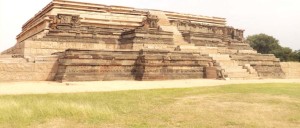
Nature provided natural defence
Nature was kind to Hampi and endowed it with a great strategic position. Bounded by the wide Tungabhadra River on one side and blocked by ranges of craggy hills on the other sides, Hampi provided a perfect example of great natural defence system which the Vijayanagara kings used to their best advantage. They encircled the city within seven lines of massive fortification, with the outer line enclosing more than 26 square kilometers. The fortifications had massive walls and strong gateways, built of large blocks of dressed stone without any cementing material, and the gateways were huge enough to allow elephants through them.
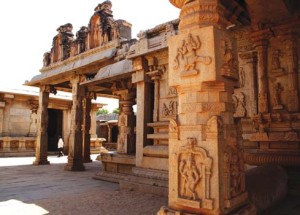
Among them, only the innermost (seventh) fortification is best preserved, and the others have gone. The Talarigattu Gate forming the northern entrance to Vijayanagara (while coming from Anegundi) is in good shape. The 18 m high Domed Gate served as the main entrance to Hampi from east and south. The massive and strongest Bhima’s Gate lying between Domed Gate and Ganigitti Jain Temple has a remarkable sculptured slab of Bhima. While coming from Hospet, the passage connected Domed Gate, Bhima’s Gate and the southeast gate in the citadel wall, giving access to the east of the city.
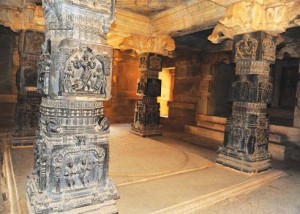
The best way to experience Hampi is to take a leisurely walk through the eloquent ruins. Most important structures and ruins are located in two areas, generally referred to as the Royal Citadel and the Sacred Centre. The Royal Centre in the southwest part of the village contains structures that might have been palaces, baths, pavilions, royal stables and temples for ceremonial use. The Sacred Centre is situated on the northern edge of the city along the banks of the holy Tungabhadra River.
Inside the Royal Citadel
Beginning with the Queen’s Bath, the tourist comes across a series of monuments in the Royal Citadel area. The Queen’s Bath is a beautiful large square building with a plain exterior and an ornate interior. It has a bath (pond), 15m square and 1.8m deep surrounded by decorated corridors and projecting balconies. There is a stone canal for carrying water to the central pond. There are four outlets at the bottom of the pond for the used water to flow out. The pond is said to have been used by women of noble families and occasionally by the king himself.

The Royal Citadel is the nucleus of Hampi city, with three entrances, two in the north and one in the west. Among the
semi-ruined structures that exist here, the Mahanavami Dibba or Dasara Platform and Throne Platform are well worth a visit. This massive east facing platform rises to a height of 12 mtrs and is built in three diminishing tiers. The first tier and the one above it measures 40 and 24 square mtrs respectively and are built of well dressed massive granite blocks. Pictures showing foreign ambassadors and Holi celebrations have been carved on its surface. There are panels of sculptures showing elephants, horses, and a lion attacking an elephant, while the lion is being attacked by a horse-rider with a sharp bow. Krishnadeva Raya built this platform to commemorate his conquest of Orissa. According to some sources, this was the place from which he viewed the nine day festivities of Dussehra. By all means, it was a hub of religious ceremonies like Durga Puja and Navaratri. On the northern side of the platform is a well paved passage, which was used by dignitaries to climb on to the platform.

The other important structure in the royal enclosure is the north facing Durbar Hall often called the King’s Audience Hall, built on a huge platform, with a flight of steps to reach it. It was a 100 pillared – hall with 10 rows of wooden pillars, each row containing 10 pillars. Its remains show how grand a palace it would have been during the Vijayanagara times.
The Hazara Rama Temple is a veritable picture gallery and a connoisseur’s delight. The name ‘Hazara Rama’ seems to have been derived from the ‘thousand images of Rama’ carved on the temple walls. Its outer walls are richly carved in bold bass relief and depict scenes from the Ramayana. Incidents like Dasaratha performing sacrifice to beget sons, the birth of Rama, his exile into the forest, the abduction of Sita, the fight between Rama and Ravana are richly carved in stone-panels. The boldly carved panels are in five horizontal rows, one above the other, representing a procession of elephants with riders and attendants, prancing horses with riders and horses led by grooms, wrestlers and soldiers in procession witnessed by a few seated royal figures. This temple also has a variety of sculptures depicting Vishnu in some of his other incarnations. The incarnations of infant Krishna are particularly endearing. Four exquisitely carved and polished pillars of black stone are placed at the centre of the ardha-mandapa. These massive cubical pillars have bass reliefs showing Ganesha, Mahishasuramardini, Hanuman and several forms of Vishnu. The Kalki avatara is shown here with four arms, astride a horse, holding a shankha (conch), chakra, (wheel), sword and a shield.
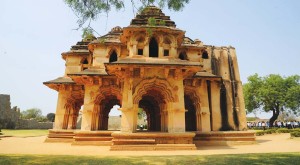
The large walled area popularly known as Zenana enclosure comprises Queen’s Palace, the Lotus Mahal, the women’s guards quarters and a water pavilion, all enclosed within a huge curtain wall. Svaramelakalanidhi, (a classic literary work written by Ramayamatya Todarmal, a Vijayanagara poet and architect in 1549), and some recently found inscriptions refer to it as that of king Rama Raya (1542-65). Women guards’ quarters is situated in the north-west corner of the Zenana enclosure. There are three watch-towers one each on the north, north-east and south-east.
Lotus Palace
The most gorgeous building that draws the tourist’s attention here is the Lotus Palace, also known as Chitrangini Mahal. This two-storeyed structure is a blend of Indian and Islamic architectural styles. Its pillars, arches and windows are Islamic in character while the sikharas or spires of Hindu order. The ground floor is built on a designed basement consisting of an open pavilion made up of 24 square pillars. The upper floor has a number of balconies with windows and arched openings. The windows were once fitted with wooden shutters and silk curtains.
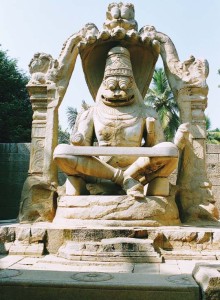
The centre of the ceiling has a deep clerestory elaborately ornamented with stucco arches, friezes and ledges, pushpapodigai corbels and large niches with remnants of seated figures and culminates in an ornate lotus bud at the top. The superstructure consists of nine pyramidal sikharas of varying sizes, the central one being the tallest. While the entire structure is built with fine stucco work, its staircase is severely plain without any ornamentation. Svaramelakalanidhi refers to this palace as Ratnakuta, where the king Rama Raya may have spent time with scholars well-versed in literature, music and art.
A long lofty and dignified structure of considerable size is situated in the north of the Zenana enclosure. These are the Elephant Stables which show elements of Indo-Islamic architecture and have 11 large chambers with beautiful arched entrances. Ten of these are crowned by large domes. The domes over the roof are of different types – circular, ribbed ones and vaulted octagonal ones with ribbed sikharas – and are arranged systematically on either side of the central chamber. However the central chamber differs from the rest and it has a square, turret-like super structure
over a flat ceiling.
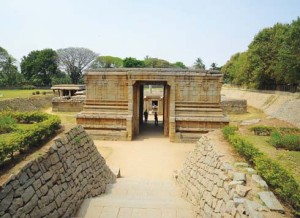
The Sacred Centre
The Ranganatha Temple and Chandrasekhara Temple are worth visiting. At some distance to the north of the Chandrasekhara Temple is a small rock cut cave temple with an empty sanctum known as Onti gundina padasala. To the south of this is the Sarasvati Temple. The Vaishnava motifs carved on its walls and an epigraph dated AD 1554 referring to Tiruvengalanatha suggest that it was originally a Vaishnava shrine.
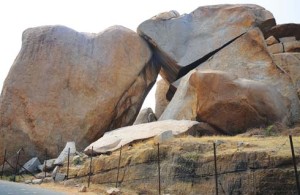
The beautiful Ganigitti Jain Temple – an early Vijayanagara structure, popularly known as the Oil Woman’s temple is a Jaina shrine situated on the Kampili Road, on the way to Bhima’s Gate. A lofty maanastambha or ‘pillar of honour’ in front of the portico contains an inscription stating that Iruga, a minister of Bukka II, built the temple in 1385. It was constructed in the reign of Harihara II (1377-1404) and was known as the Chaityalaya of Kunthu Jinanatha, the 17th Jaina Tirthankara.
The Pattabhirama Temple situated on the outskirts of Vijayanagara, about a kilometer east of Kamalapura, is supposed to have been built by the Vijayanagara ruler Achyuta Raya (1529-42). This east facing temple complex has a large courtyard (163.7m x 93m) which is enclosed by a high (7.6m) prakara.
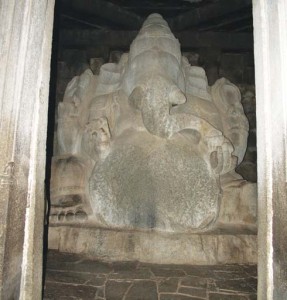
The Sacred Centre abounds in temples and a tourist entering Hampi from Kamalapura side, can see a number of them. One comes across the underground Shiva Temple also known as Prasanna Virupaksha Temple. The temple’s floor lies below ground level. The mandapa has a large broken slab with an inscription that records a grant to the temple of Prasanna Virupaksha by Krishnadeva Raya on the occasion of his coronation. Proceeding further northwards, the visitor meets a gigantic natural arch formed of two huge boulders, leaning on each other. They are called Sister Rocks in local parlance. Further ahead is the Chandikeswara Temple, a typical Vijayanagara structure. It was a Vaishnava temple since the reliefs on the pillars have Vaishnava themes. The sanctum sanctorum is empty and open to the skies and has pitha (pedestal) carved with the figure of Garuda in the anjali (palms held together, symbolic of devotion) post. The amman-shrine is also in the same style. The amman shrine is a separate shrine in Shaiva and Vaishnava temple complex consecrated to the goddess amman as consort of the principal deity. A pillared cloister runs around both the shrines.
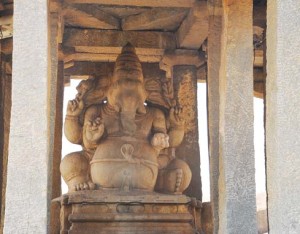
A short distance to the west of the road, the visitor can see a huge monolith image of Lakshmi Narasimha known as Ugra Narasimha. The gigantic 6.7 m high image executed in 1528, was one of last additions to Hampi made during the rule of Krishnadeva Raya. It is a four-armed seated figure of Narasimha, but all the arms are broken now. He is shown seated on the coils of a large naga (serpent) Adisesha, with seven hoods serving as a canopy. The entire image is set within a makara-torana or arch, with a lion-mask above the hoods of Adisesha. To the left of the above image is a monolithic enormous Shivalinga called Badavi Linga. The base of this 3 metre high linga is permanently under water.
Krishnadeva Raya built the Krishna Temple in 1513 A.D to commemorate his victory over Prataparudra Gajapati, the ruler of Orissa. During this battle, Krishnadeva Raya seized an image of an infant Krishna, brought it as a war trophy to Hampi and enshrined it in the maha-mandapa of this temple in 1515 A.D. A slab on the front of the temple has an inscription describing the conquest and consecration of the temple on 16 February 1515 by Krishnadeva Raya. The superstructure of its east gopura is partially damaged, but its west face contains fine stucco figure of warriors with shields, spirited horses and elephants.

The east facing temple is built in the typical Vijayanagara style – it has a sanctum, an ardha-mandapa, a circumambulatory passage, a pillared hall with three entrances, among other elements. The sanctum is at present empty. The image of Krishna showing him as an infant, holding butter in his right hand, is now placed in the Government Museum at Chennai.
The inner sides of the entrances are adorned with beautifully sculptured apsarasas, standing on mythical animals and holding scrolls filled with panels, showing the 10 incarnations of Vishnu. A pillar in the ardhamandapa shows all the ten avataras of Vishnu, including the rare one of Kalki, depicted as a seated figure with a horse’s head. Beyond the Krishna temple, on the slope of the Hemakuta hill are two huge stone images of Ganesha. The one called Sasivekalu (mustard seed) Ganesha is about 2.4m high. The four-armed Ganesha holds ‘Ankusha’ or goad and ‘Pasha’ or noose in the upper hands. The lower right hand holds a tusk while the lower (now damaged) once held a sweet ball or modaka. The belly is tied with a snake. The image is covered by a large and open mandapa with plain rough square pillars. Nearby is another monolith, namely Kadlekalu (gram-seed) Ganesha. The huge seated figure carved out of a massive boulder, is 4.5 m high and enshrined in a large temple with an open pillared mandapa in front. The Hemakuta Hill offers a panoramic view of Hampi and is famous for its spectacular views of sunset.
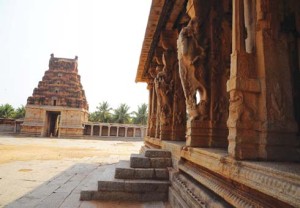
Virupaksha Temple – the most sacred of them all
Life revolves around Virupaksha Temple in Hampi and the tourist cannot escape the overpowering presence of its watchful high gopura. Virupaksha Temple also known as Pampapati Temple is the most sacred and ancient temple at Hampi and parts of the temple are older than the city itself. It is situated on the southern bank of the Tungabhadra, immediately to the north of the Hemakuta Hill. A famous legend is associated with it. Pampa is the most ancient deity of the area. According to local sthalapurana, Pampa was the daughter of Brahma. She performed penance (tapas) in this holy place, concentrating on Shiva, who was meditating on Hemakuta Hill. Her penance bore results. Shiva appeared before her and took the shape of a Shivalinga. That idol of Shivalinga is Virupaksha. Their wedding celebrated annually in the Virupaksha Temple is an elaborate affair. The name Hampi itself is probably derived from the goddess’ name, as the letters ‘P’ and ‘H’ are often interchanged in Kannada.
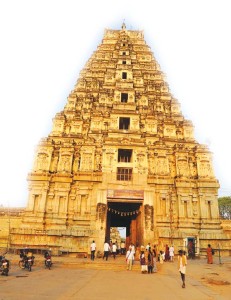
A lofty eastern tower (gopura) forms the main entrance to the Virupaksha Temple. Its nine storeyed gopura is popularly known as Bistappa Tower and is said to have been built by Proluganti Tippa, a commander of Devaraya II (AD 1422-26). This tower is 50.29 m tall, 45.72 m wide and 36.56 m long. After passing through it, the visitor enters into the first prakara (outer courtyard) which is 40 m long and 155.4 m wide. A narrow channel of the Tungabhadra flows along the terrace descends into the temple kitchen and finally flows out through the outer courtyard. It is covered by flat stones. There are rest-rooms for stay of pilgrims who come from far off places. The left corner has the office room and a big school. On the right side is the Pooja Mantapa or Kalyana Mantapa.
A small three storeyed inner tower in the first prakara admits the visitor into the second prakara (inner courtyard). Krishnadeva Raya got this gopura built in 1510 and it is named after him as Raya Tower. In this inner prakara, one can see the dhwaja stambha and deepa stambhas. Pilgrims light up lamps here in the month of Kartika. On the left side are Pathaleswara Temple, Mukti Narasimha Temple and Suryanarayana Temples and on the right are the Lakshmi Narasimha and Mahishasura Mardhini Temple.
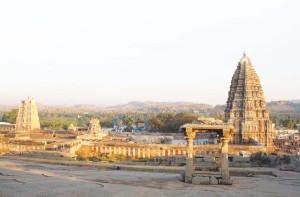
The Ranga Mandapa consits of 38 pillars decorated with sculptures. These pillars are divided into two vertical sections – the first is cut to resemble a rearing Yali – a mythical lion, standing on a makara, while the second section is basically square with small reliefs depicting mostly Shiva themes. The pillars are aesthetically composed.
The ceiling of the large front Ranga Mandapa has a magnificent series of paintings. Here is a great masterpiece showing a large procession with sage Vidyaranya in a palanquin preceded and followed by a large retinue. Other themes include Arjuna shooting the matsya-yantra to win the hand of Draupadi, the Dasavataras and Shiva as Kamadahana-murthi. The sanctum enshrines the well-known Virupaksha-linga.
To the north of the Virupaksha Temple are two temples related to Pampadevi and Bhuvaneshwari devi. Outside the Pampadevi Temple, on the left side are navagraha (nine-planet) idols. The northern tower is called Kanakagiri Gopura. This houses the Ratna Garbha Ganapathi and devi idols. As one emerges from the Kanakagiri Gopura, one finds a huge Manmatha Pond, in which Virupaksha’s Theppotsava is performed.
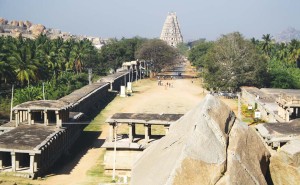
There are steps on the rear side of the temple, giving access to a dark room on the right side. The room has a slit in its eastern wall and the light passing through it falls on the western wall creating the inverted shadow of the Bistappa tower. One can only marvel at the genius of the Vijayanagara architect who created such a masterpiece.
After climbing the steps, the visitor finds the Sri Vidyaranya temple to the west. About 15 yards away is the magnificent matha of Sri Vidyaranya housing a serene pooja room. Further south, a small door gives access to a pond called Lokapavana Teertha.
The wide street extending to the east from the main entrance of the temple is called Royal Street or Hampi Bazaar. The temple’s chariot also occupies a place on it. The 10.6m wide and 732 m long street is flanked by double storeyed colonnaded structures and ruined mandapas on both sides.
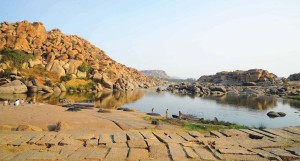
At the far end of the street, stands the Matanga Parvata (hill) with wide steps leading up. There is a beautiful two storeyed mantapa with 12 well-carved and polished black stone pillars, dating back to the time of Chalukyas. Behind the mantapa stands a gigantic Nandi idol, facing west. As the Nandi (basava) faces the Shiva idol in the Virupaksha Temple, it is called Eduru Basavanna (basava facing Shiva).
The beautiful walkways
Hampi is dotted with ancient walkways which have been trod since time immemorial. One such path runs from Krishna Temple to Vijaya Vithala Temple. But the more famous one is Kampa Bhupa Marg. While walking along the Hampi Bazar Street, just before reaching the Matanga Parvata, one finds an ancient stone bridge branching out through the greenery. This was built by Kampa Bhupa, the son of Harihara I in 1383 AD and is known as Kampa Bhupa Marg. This way takes the visitor to Kodandarama Temple, which has a deity in the form of a human figure with 16 hands. This temple is situated opposite the Chakratirtha and is the most sacred bathing ghat on the Tungabhadra. The Yantrodharaka Anajaneya Swamy Temple stands closeby. From here,one can visit the ruins of a famous street, which was once famous as Achyutapete but is now popularly known as Soolai Bazaar (Courtesan’s Street). At its southern end is the large Achyuta Raya Temple encircled by two prakaras. It was built by Salakaraju Tirumaladeva, an officer of the king Achyuta Raya (1530-42), and is famous for Achyuta Raya Temple, rather than the name of the enshrined deity Tiruvengalanatha. The temple resembles the Krishna Temple in almost all respects, except that it has two enclosures, arranged in a concentric manner, each marked by an entrance gopura. The inner enclosure has the main temple. A pillared cloister runs around the temple (This temple is also reached by climbing the steps next to Eduru Basavanna).

The ruined structures beckon the tourists all around and the Tungabhadra River caresses their feet as one proceeds towards the Vijaya Vithala temple. A variety of birds can be sighted in the morning along this route. On the way, the Purandaradasa Mantapa makes a magical appearance. Purandaradasa worked for the development of Kannada literature through his songs, and was in Vijayanagara in 1540. Further ahead, one comes across the King’s Balance, with two lofty pillars of carved granite, supporting a stone beam provided with three hoops on the underside. One of the pillars has a bas-relief depicting a king and two queens, possibly Krishnadeva Raya and his consorts.
Musical pillars at Vijaya Vithala Temple
The tourist now finds himself at the internationally famous Vijaya Vithala Temple, the crowning glory of Hampi that represents the culmination of the Vijayanagara style of art and architecture. No other building in Hampi can be compared with it in terms of florid magnificence. Krishnadeva Raya is said to have built a substantial portion of it under his patronage (1509-29). Vithala Temple stands in a large enclosure (164m x 94.5m). All along the enclosure walls on the interior side are pillared colonnades. In front of the main temple is the stone chariot. At the centre of the enclosed courtyard is the sanctum with its axial mandapas. Arranged around the sanctum is the amman shrine, the kalyana-mandapa, and utsava-mandapa, a 100- pillared-mandapa and a stone ratha or chariot dedicated to Garuda, the mount of Lord Vishnu. This chariot (with the image of Garuda on it) replaces the Garuda shrine normally seen in Vaishnava temples.
The main temple was dedicated to Vishnu as Vithala. The large maha-mandapa has symmetrically recessed sides, measuring upto 30.5m at its widest and longest points. The mandapa contains 56-pillars, each around 3.6 mtrs high, 40 of these are arranged to form an aisle around three sides, while the remaining 16 form a rectangular court in the centre. The pillars have heavy Pushpapodigai corbels (curved corbelbracket on top of pillars terminating in a flower and bud.)
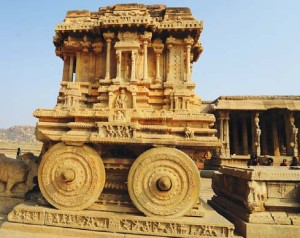
Vishnu
The ceiling of the mandapa is divided into sections and carved beautifully with lotus motifs. The central court is now almost roofless. The outermost pillars of maha-mantapa are called musical pillars. They emit the seven notes (Sa, Ra, Ga, Ma, Pa, Dha, and Ni) of the Indian classical music when gently struck. Callous attitude of the tourists has damaged many of these pillars and tapping on them is banned for the sake of preservation. The dilapidated five aisled ardha-mandapa leads to a covered pradakshina-patha (circumambulatory passage) running around the now empty garbhagriha and antarala.
The kalyana mandapa to the south-east of the courtyard almost surpasses the maha-mandapa in its richness of designs. It also has an open pillared mandapa, symmetrically planned with deeply recessed sides with usual arrangement of composite pillars, balustrades and a highly ornate ceiling.
The sacred Hemakuta hill is dotted with numerous shrines and mandapas. Interestingly, all the structures with stepped pyramidal vimanas found in and around Hampi are Shaiva shrines. A small structure further east on the southern bank of the Tungabhadra is a Vaishnava shrine and those in the south eastern part of the city are all Jain shrines. The Malyavantha Raghunatha Temple is a Vaishnavite shrine on the Malyavantha Hill that lies to the east of the Talarigattu Road. There is a large, five-storeyed gopura on the south, and a smaller threestoreyed one on the east.
The ruins of Hampi are extensive and fascinating enough to sustain the tourist’s interest for several days. There is always something new to discover in Hampi. Photography and archeology buffs should plan for a longer stay whereas those in a hurry can complete the tour within two days. Hampi is a tourist’s paradise and a must-visit destination in Karnataka. The Hampi group of monuments was inscribed on the list of UNESCO’s World Heritage Monuments on 5 December 1986.

